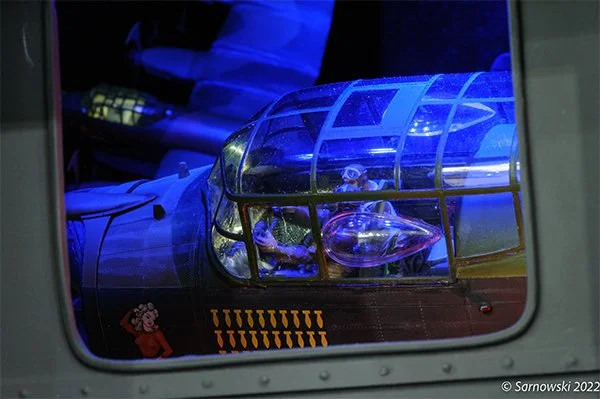At the MMSI show in October, 2022, the HK Models 1/32nd nose art kit really caught my eye on M&Models’ vendors’ table, and I picked it up on a whim (I loved detailed interiors!), whereupon my pals Barry Biediger and Pat Vess both asked, “Are you going to put that in a box?” I hadn’t intended to, but that seemed like a swell idea, and a chance to really push some forced perspective, as well as a unique angle on a plane-in-a-box that I hadn’t seen anyone attempt before (coming from the extreme right of the frame into the center, which had the added advantage of cutting off those huge wings and troublesome props, too). The diorama is pretty self-explanatory, with the other key ingredients being the Tori Factory crew figures set (most with some conversions), the old Minicraft 1/144th Lancaster kit, and a scratchbuilt German city below. Self-explanatory, but not necessarily easy: The HK kit proved to be a real challenge, with the fuselage not really fitting properly around the interior (look at all of that Bondo! And that’s not even considering the fact that I wound up having to graft more fuselage on to the kit, along with parts of the wings, and bomb bay doors). The Minicraft kit was also a real turkey), which also needed a lot of filling and additional work, and the cityscape below required a lot of patience (all of those tiny plastic squares and rectangles cut on the Chopper; ouch!). I can’t complain, though: This project was a lot of fun for the most part, and in the end, I’m proud to say the box claimed a Gold Medal in the Historical Open division at the MFCA Show in May, 2022.
Above: The figures in place in the interior, and the cockpit lights. I was especially proud of the navigator and radio operator’s gooseneck lamps, scratched based on pictures I found on the Web of the real things. Damn shame so much of this isn’t visible (especially considering the aftermarket kit I bought to enhance the details), but you never know what will be seen until you’re far along in the diorama (and, in this case, the nose of the plane is all sealed up). The rest of the lighting in the box comes from cool LEDs with filter gels for the “moonlight,” and red/orange for the eerie fire glow on the city.
Glue; clamp; add filler; sand; prime. Then: Repeat, repeat, repeat. Ugh.
The cityscape, airbrushed in shades of gray and black, and the 1/144th Lancaster, which I really wanted to include (and also lit) to give a sense of how big the bomber in the foreground really was, and what the rest of it looked like. The smaller plane is not really visible in the photos, but if you see the box in person and crane your neck, it comes into much better view. Oh, and I love those prop blurs that Barry recommended to me!
Positioning the nose of the 1/32nd Lancaster (pre-weathering in the top shot, and without the canopy in both pictures—that also didn’t fit right, by the way). This took a lot of trial and error. The three walls of the inner box and its top were all covered with black velvet, which nicely disappeared in the finished diorama.
The bombadier and his battle station, pretty much invisible in the finished diorama, but hey, as Shep always said of the interiors of the big bombers he built for Monogram, “I know it’s there!”
For the reveal on this one, I decided to avoid the usual black-velvet-over-wood and scratched a section of the interior with window, airbrushed in dark gray. It’s not totally to scale, but I wanted to give some sense of viewing the other planes from a third Lancaster in bombing formation. (Yes, I know it wouldn’t have been that close, but it’s a bit of artistic license, inspired by Dennis Levy’s German bomber box.)
Photo by Bob Sarnowski when I brought the box to the 2022 MMSI Show. (It won a Gold Medal in Ordnance Open.)












